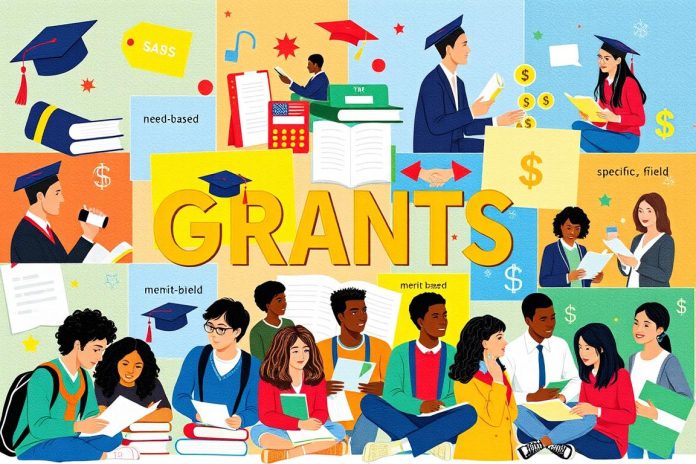You’re right at the brink of a great chance. You have an acceptance letter from your dream school, but money is a big problem. In your journey to the future, educational grants are like golden threads. They help get past the hurdles of tuition and other costs1. Institutions like Rush University and the Illinois Monetary Award Programs give out much needed aid. They make sure money issues don’t stop students from pursuing their dreams1. Federal Pell Grants offer as much as $7,395 for the 2024-2025 school year. And you might get even more from state programs like the Illinois Monetary Award Programs. This shows how the government supports your educational goals12.
There’s a lot of money from programs like the System Transformation Grant and the Girls’ Education Accelerator. These grants are vital for making big changes and allowing everyone equal access to education1.
Aiming for college grants, enhancing your career, and educational success is all possible. Educational grants remove the financial barriers that could block your way. They provide aid for tuition and support a wide range of subjects. With efforts like the National Health Service Corps Scholarship Program in healthcare and NEA-backed grants for teachers, the choices for scholarships are wide12. It’s important to see the big potential in these grants. They can change your life and help reform the education system. Sadly, many scholarships aren’t claimed every year. By taking action, you could turn uncertainty into a future filled with academic success and new opportunities1.
Key Takeaways
- Educational grants can dramatically decrease the financial burden of higher education.
- Grants come in various forms, including Federal Pell Grants, state grants, and field-specific scholarships.
- Utilizing unclaimed grants can provide untapped opportunities for college and career development.
- Programs like the System Transformation Grant emphasize the significant role of grants in education reform and diversity.
- Eligibility can be based on a multitude of factors, ensuring a wide range of students have a chance at obtaining financial aid.
- Grants are not just for tuition but can also cover living expenses and academic materials.
- Educational grants celebrate not only financial need but also academic excellence and talent.
Understanding the Various Types of Educational Grants Available
In today’s academic landscape, financial aid options play a crucial role in providing access to higher education. Among these, grants for students and academic scholarships are pivotal, offering opportunities that vary significantly in their sources and criteria.
Grants and scholarships are essential tools in advancing educational funding. They are traditionally categorized into two primary types: those based on financial need and those awarded for merit. Grants often focus on lifting financial barriers for students, while scholarships may reward academic, talent-based, or demographic achievements. Both the federal and state governments are key in providing educational funding, with programs such as Pell Grants and TEACH Grants3.
Aside from government-funded opportunities, there’s substantial support under Title programs and the Individuals with Disabilities Education Act (IDEA). These focus on educational enhancements and support. For example, Title I funding helps low-income students meet state standards. At the same time, IDEA provides for the educational needs of children with disabilities4.
| Type of Funding | Source | Main Criterion | Unique Aspect |
|---|---|---|---|
| Pell Grants | Federal Government | Financial Need | Available to undergraduates |
| TEACH Grants | Federal Government | Service Agreement | For aspiring teachers in high-need fields |
| Title I | Federal Funding | Low-income Status | Improves academic achievement |
| IDEA Funds | Federal Funding | Disabilities | Supports special education |
Scholarships can also vary, supporting anything from academic excellence to specific talents like athletics or arts. Many organizations offer scholarships based on a wide range of criteria. These criteria can include academic performance, field of study, or even personal backgrounds3.
Exploring the range of financial aid options available can be a big step in your educational journey. By understanding and using these diverse grants for students and academic scholarships, you open doors to opportunities. These can significantly help in reaching your academic and career goals.
The Application and Eligibility Process for Securing Educational Funding
Getting educational funding can change your education path. There are many scholarship opportunities and grants for students. To use these tuition assistance and financial aid for education, you need to know how to apply and qualify.
Navigating the System for Award Management (SAM) Registration
If you’re a school district or a non-profit, SAM registration is key. It’s your first step to getting federal education funds and managing grants. You should plan for up to 10 business days for the process. This might take longer if there are mistakes in your application5.
Deadlines and Timing: Critical Factors in Your Application Success
Knowing when and how to apply for grants is important. Federal grant applications are usually open from November to April. It depends on the funds Congress allocates. To increase your chances of getting a grant, submit your application 30 to 60 days after the window opens5.
Writing a Compelling Grant Proposal: Tips for Institutions and Individuals
Writing a grant proposal requires clear and achievable plans. Whether it’s for a System Capacity Grant or an education program, include a detailed cost analysis. Your proposal should match your institution’s goals. Use your budget skills to show your project is possible6.

The Art of Crafting a Winning Application: Insights and Best Practices
When applying for grants, be accurate and adaptable. Show how your project fits the funder’s criteria. Make sure your institution’s needs and the expected outcomes are clear. Working together, having the same goals, and clear plans can help get college grants and academic scholarships. This boosts your education chances5.
To win funding, you need a strategic plan. Understanding how to make your grant proposal writing clear and focused is crucial. Doing this can greatly raise your chances of getting the financial aid needed for education7.
Benefits of Educational Grants
Educational grants change lives and the entire education world. They help overcome financial hurdles, encourage societal growth, and propel educational changes.
Overcoming Financial Barriers to Educational Access
Financial help and grants for career growth make education reachable for many. Teachers, vital for learning, made 17 percent less than other college grads in 2015. This was the largest wage gap in over 30 years8. Such facts highlight the need for financial backing, as teachers often spend close to $500 yearly on classroom materials8.
The Ripple Effect of Grants: From Individuals to Broader Educational Reform
Grants don’t just help people; they push society forward. Take Massachusetts’ school finance reforms, for example. They vastly improved student performance by wisely using state funds where needed most8. A study found boosting spending per student by 20 percent yearly could greatly help low-income students do better in the long run8.
The Role of Grants in Supporting Diversity and Innovation in Education
Grants also boost diversity and new ideas in education. The TEACH Grant aims to ease financial stress. It draws a mix of educators to work in needy areas and schools9. The Biden-Harris Administration has plans to double this grant. This will make it more effective in fighting teacher shortages9.

Educational grants also help create teaching methods and learning that include everyone. For example, grants fund Project Lead The Way. This allows students to dive into advanced computer science, encouraging early STEM interests8.
| Grant Program | Impact | Focus Area |
|---|---|---|
| TEACH Grant | Up to $8,000/year for teaching students | High-need fields in underserved schools |
| Project Lead The Way | Implementing a K-12 CS program | STEM Education |
| EmpowerED Grant by T-Mobile | Provided MiFi hotspots for better technology access | Digital Learning |
In conclusion, educational grants do more than give money. They’re crucial for building a world that’s more inclusive and educated. These grants benefit individuals and society, proving how important such financial and support systems are in creating a diverse and energetic educational setup.
Conclusion
Scholarships play a crucial role in education today. They change lives by changing how we learn and grow. They build a smarter, more skillful society. Knowing that Pell Grants can cut costs by up to $3,90810 is key. This shows how big an impact they have. With grant applications opening between July 1, 2025, and September 1, 202511, it’s time to get ready.
Getting these grants is tough, though. Studies show the challenge of making education fair for everyone. Areas with high poverty get less money per student12. We need a better way to fund education, so everyone has a fair chance. Working on your ideas, especially in STEM, and following guidelines11 will help you stand out.
So, as you aim high in school and beyond, remember the power of scholarships. They open the door to learning without the stress of money. Better federal support can make education fair for all12. Stay informed and committed. Use these chances to better your life and strengthen our society. For more on how policy shapes education, check out the insights at the National Academies of Sciences, Engineering, and12.
FAQ
What are the benefits of educational grants for students?
What types of educational grants are available?
How do I find and apply for educational grants?
What is the System for Award Management (SAM) Registration, and do I need it?
When are most educational grant applications due?
What are some tips for writing a compelling grant proposal?
How do educational grants contribute to broader educational reform and societal development?
Can educational grants support diversity and innovation in education?
Source Links
- Free Money for Education: The Lifelong Benefits of Educational Grants – https://blog.consumertestconnect.com/free-money-for-education-the-lifelong-benefits-of-educational-grants/
- Maximize Your Learning: Discover the Top Benefits of Educational Grants for Your Future! – Consumer Test Connect – https://blog.consumertestconnect.com/maximize-your-learning-discover-the-top-benefits-of-educational-grants-for-your-future/
- Grants, Scholarships & Loans: What’s the Difference? – School of Education – https://drexel.edu/soe/admissions/financial-aid/difference-between-student-grants-vs-loans/
- Title Funds in K-12 Schools – Ellipsis Education – https://ellipsiseducation.com/blog/what-are-title-funds
- Grant Eligibility | Grants.gov – https://www.grants.gov/learn-grants/grant-eligibility
- How to apply for grants | Global Partnership for Education – https://www.globalpartnership.org/funding/how-apply-grants
- New to NIH | Grants & Funding – https://grants.nih.gov/new-to-nih
- The Importance of Leveraging Grant Opportunities for School Success – Inside INdiana Business – https://www.insideindianabusiness.com/articles/the-importance-of-leveraging-grant-opportunities-for-school-success
- Department of Education Implements TEACH Grant Program Changes to Benefit Teachers and Students – https://www.ed.gov/news/press-releases/department-education-implements-teach-grant-program-changes-benefit-teachers-and-students
- What are the benefits of securing research funding for your academic institution? – https://www.linkedin.com/advice/1/what-benefits-securing-research-funding-your-academic
- NCER Assistance Listing Number (ALN): 84.305A Education Research Grants Program Request for Applications – https://ies.ed.gov/funding/pdf/2025_84305A.pdf
- Public education funding in the U.S. needs an overhaul: How a larger federal role would boost equity and shield children from disinvestment during downturns – https://www.epi.org/publication/public-education-funding-in-the-us-needs-an-overhaul/

